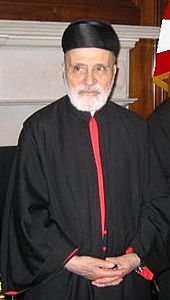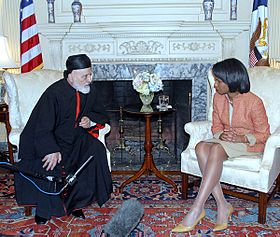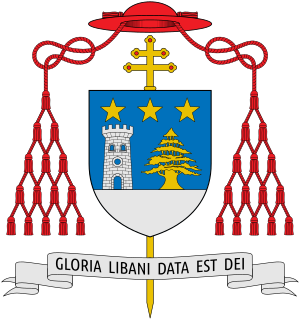Nasrallah Boutros Sfeir facts for kids
Quick facts for kids His Beatitude Moran Mor Nasrallah Boutros Sfeir |
|
|---|---|
| Cardinal Patriarch emeritus of Antioch | |
 |
|
| Native name | Arabic: نصرالله بطرس صفير |
| See | Antioch and the Whole East |
| Appointed | 7 May 1986 |
| Reign ended | 26 February 2011 |
| Predecessor | Anthony Peter Khoraish |
| Successor | Bechara Boutros al-Rahi |
| Orders | |
| Ordination | 7 May 1950 |
| Consecration | 16 July 1961 by Paul Peter Meouchi |
| Created Cardinal | 26 November 1994 |
| Rank | Cardinal-Bishop Patriarch |
| Personal details | |
| Born | 15 May 1920 Rayfoun, Lebanon |
| Died | 12 May 2019 (aged 98) Achrafieh, Beirut, Lebanon |
| Previous post |
|
| Coat of arms |  |
Nasrallah Boutros Sfeir (born May 15, 1920 – died May 12, 2019) was a very important religious leader in Lebanon. He was the head of the Maronite Church, which is the largest Christian group in Lebanon. This church is part of the Eastern Catholic Churches, meaning it is connected to the Holy See (the Pope) in Rome.
He was also given the special title of Cardinal. He became the Patriarch of Antioch for the Maronites on April 27, 1986. He held this role until his retirement was accepted on February 26, 2011. He was the 76th Patriarch of the Maronite Church. His official title was "His Beatitude the 76th Patriarch of Antioch and the Whole Levant."
Contents
Early Life and Becoming a Priest
Nasrallah Sfeir was born in Rayfoun, Lebanon, on May 15, 1920. He went to school in Beirut and other places in Lebanon. He studied philosophy and theology at Saint Joseph's University in Beirut.
In 1950, he became a priest. From 1951 to 1955, he worked as a priest in his hometown parish of Rayfoun. In 1956, he became the secretary for the Maronite Patriarchate, which is like the main office for the Maronite Church. He also taught translation at a school in Jounieh.
In 1961, Sfeir was appointed a "Titular Bishop" and a "Patriarchal Vicar." This meant he had the title of a bishop for a historical area and helped the Patriarch directly. He was officially made a bishop on July 16, 1961.
Becoming the Patriarch
Nasrallah Sfeir was chosen to lead the Maronite Church by a group of Maronite bishops. This happened on April 19, 1986. His appointment was then approved by Pope John Paul II on May 7, 1986.
Changes to Church Services
Patriarch Sfeir wanted to update the way church services were done. This work led to a new Maronite Missal (a book used for church services) being published in 1992. This new book tried to bring back older traditions of the Antiochene Liturgy. It made the "Service of the Word" (the part with readings and sermons) much richer. It also included six different "Anaphoras" (special prayers during the Eucharist).
His Role During the Civil War
Serving as an assistant to two previous patriarchs helped Sfeir prepare for his important role. He became a strong voice for peace and common sense during the later years of the Lebanese Civil War. This war lasted from 1975 to 1990.
He often spoke out against unfairness in society and politics. He also spoke up for people who were poor or had no power. His writings and speeches shared his ideas for a free and successful future for Lebanon.
At first, Sfeir tried to stay out of politics, like the patriarchs before him. But by 1989, he became deeply involved in national politics.
His Retirement
Cardinal Sfeir sent his resignation to the Vatican in late 2010. His retirement was accepted by Pope Benedict XVI on February 26, 2011.
Bishop Bechara Boutros Rahi was chosen as the new Patriarch for Antioch on March 15, 2011. He took over from Cardinal Sfeir.
Becoming a Cardinal
Sfeir was made a Cardinal by Pope John Paul II on November 26, 1994. A cardinal is a very high-ranking official in the Catholic Church, chosen by the Pope.
Because he was the head of a "sui juris" (meaning self-governing) church, he was given the special title of a "cardinal bishop." He was too old to vote in the papal elections (called "conclaves") in 2005 and 2013, as cardinals over 80 years old do not participate.
His Writings and Languages
Sfeir wrote several books. These include "The sources of the Gospel-Bkerké" (1975) and "Personalities that disappeared 1961–1974" (two volumes). He also wrote many volumes of "Sunday sermons," which were spiritual thoughts and national opinions.
He was very good at many languages. He spoke Syriac, French, Italian, Aramaic, and Latin. Of course, he also spoke his native Arabic, both the classical and Lebanese versions.
His Involvement in Politics
Spring of 1989
In 1989, Lebanon was still in a civil war. On February 17, 1989, after a fight broke out in Beirut, Sfeir brought together Christian leaders. They supported General Michel Aoun's efforts to bring back government control.
Later, in April, after more fighting, 23 Christian members of parliament asked for a ceasefire. The summer saw heavy fighting between Aoun's troops and the Syrian army.
An agreement called the Taif agreement was reached. Sfeir supported this agreement, but Aoun did not. Many people protested against Sfeir's support for the agreement. Some of Aoun's supporters even challenged Sfeir's authority at the Patriarchate. The next day, Sfeir moved to a safer area.
Some people believe the Vatican encouraged Sfeir to support the Taif accord to end the civil war. Sfeir said that it would be a "fatal error to believe that we can live alone." He also said that Aoun's refusal of the agreement was against the law.
Challenges Within the Church
Even some parts of the Church disagreed with the Patriarch. Some religious orders supported Aoun and spoke against the Taif Agreement. To help the Patriarch, the Vatican got involved. They worked to reorganize the Maronite Church.
In November 1989, the Pope's representative in Lebanon, Pablo Puente, spoke to Lebanese bishops. He said that religious people should not get involved in politics unless they were officially asked to by the Church. The Vatican also appointed "visiting bishops" to watch over some very active religious orders.
In 1990, Sfeir asked the government in West Beirut to take control of Aoun's area in the east. He said the government should rule the whole country. Finally, on October 13, 1990, the Syrian Army ended Aoun's fight, and the long civil war ended. Aoun had been against the Taif Agreement because it didn't set a clear time for Syrian troops to leave. It also reduced the Maronite president's powers. The Syrians stayed in Lebanon for another 15 years.
The Cedar Revolution
After the assassination of former Prime Minister Rafik Hariri in 2005, there were huge protests in Lebanon. This led to the Syrian army leaving Lebanon. This event is known as the Cedar Revolution.
Sfeir had sometimes criticized Syria for not leaving Lebanon earlier. But around 2003, he became quieter. After Hariri's assassination, he again spoke out against Syria's strong influence in Lebanese politics. This helped him regain his position as a main spokesperson for his community.
In 2001, hundreds of thousands of Lebanese, mostly Christians, gathered to welcome the cardinal back from a trip to the United States. During his trip, he had asked for the Syrian army to leave. He also supported the creation of the Christian Qornet Shehwan Gathering, which was against Syria's role in Lebanon.
Dealing with Political Problems
In 2006, the cardinal was concerned about political problems in Lebanon. There was a disagreement about whether President Émile Lahoud should stay in office. Sfeir said that Lahoud should only be removed in a legal way. He also stressed that the government should continue to work smoothly.
To talk about the Israel-Lebanon war in July 2006, he met with US Vice President Dick Cheney and Secretary of State Condoleezza Rice.
Relations with the Free Patriotic Movement
On October 15, 2006, the Christian Free Patriotic Movement (FPM) held protests. They used slogans against Cardinal Sfeir. They felt his political views went against what FPM Christians in Lebanon wanted. The FPM group, led by General Michel Aoun, was the largest Christian group in the Lebanese parliament.
Relations between the cardinal and the FPM, and also Hezbollah, got worse. Before the 2009 elections, the patriarch made a last-minute appeal. He warned Christians not to vote for Hezbollah and the FPM. Many believe this made the FPM lose Christian support in the elections. The FPM blamed the cardinal for losing 20% of Christian support. They also blamed him for not stopping the transfer of 15,000 Sunni voters to a Christian area.
Death
Nasrallah Boutros Sfeir passed away on May 12, 2019, in a hospital in Beirut. This was just three days before his 99th birthday. He was buried at the main church of the Maronite Catholic Patriarchate in Bkerké, Lebanon, during a state funeral. After his death, Pope Francis said that Sfeir was "a staunch defender of his country’s sovereignty and independence." He added that Sfeir "will remain a great figure in Lebanon’s history."
Arms
See also
 In Spanish: Nasrallah Pedro Sfeir de Reyfoun para niños
In Spanish: Nasrallah Pedro Sfeir de Reyfoun para niños
- List of Maronite Patriarchs
- Maronite Church



